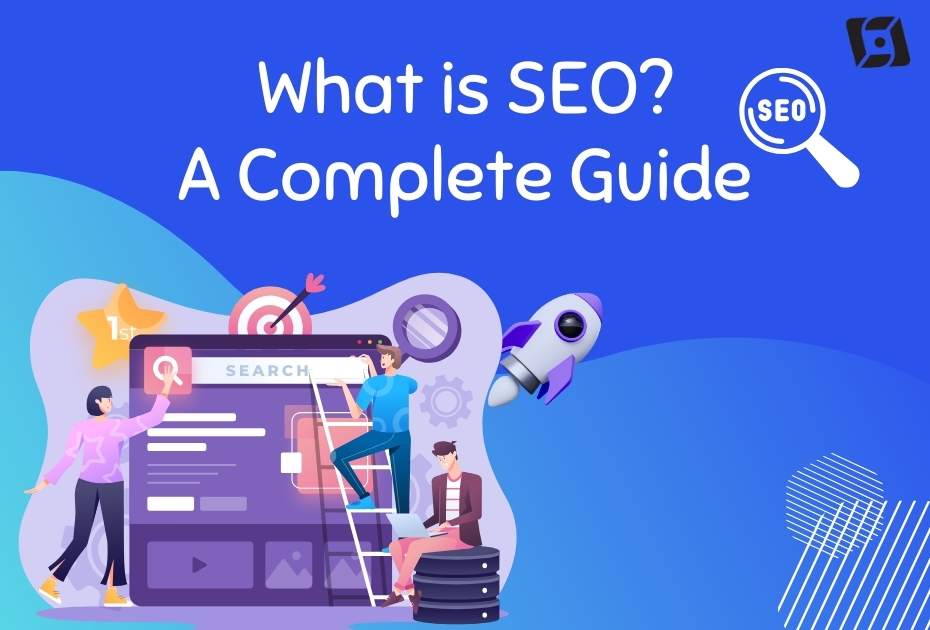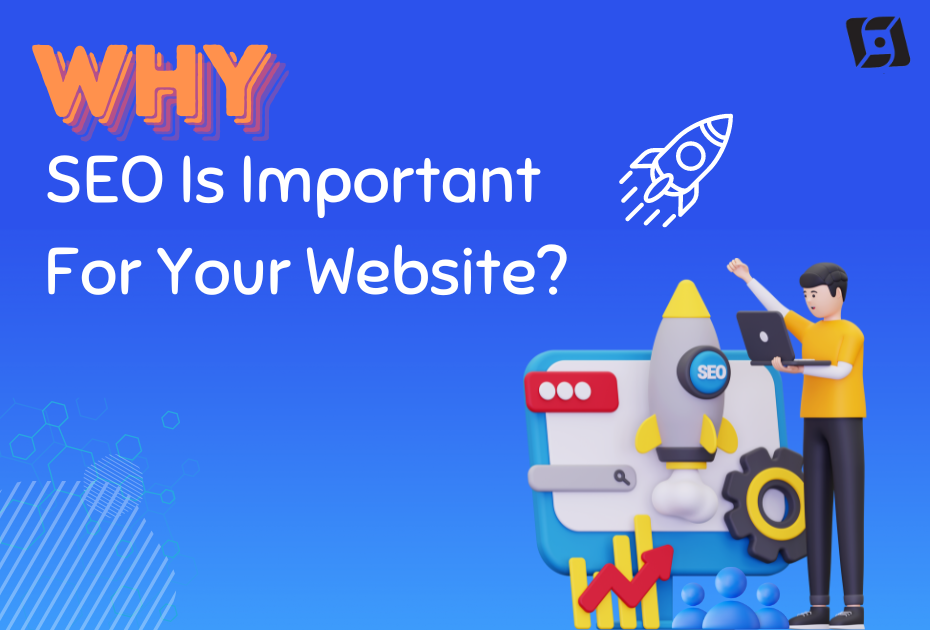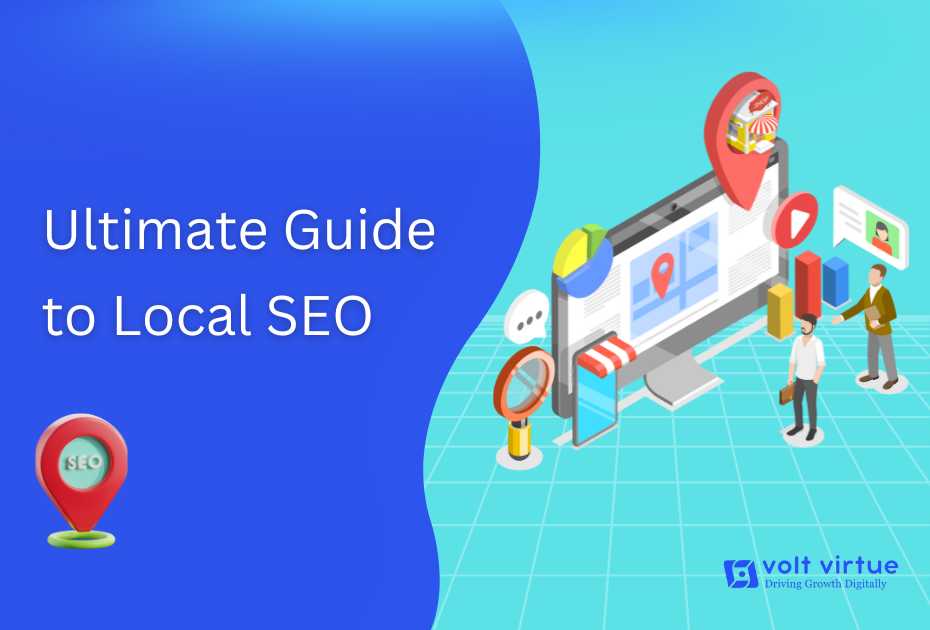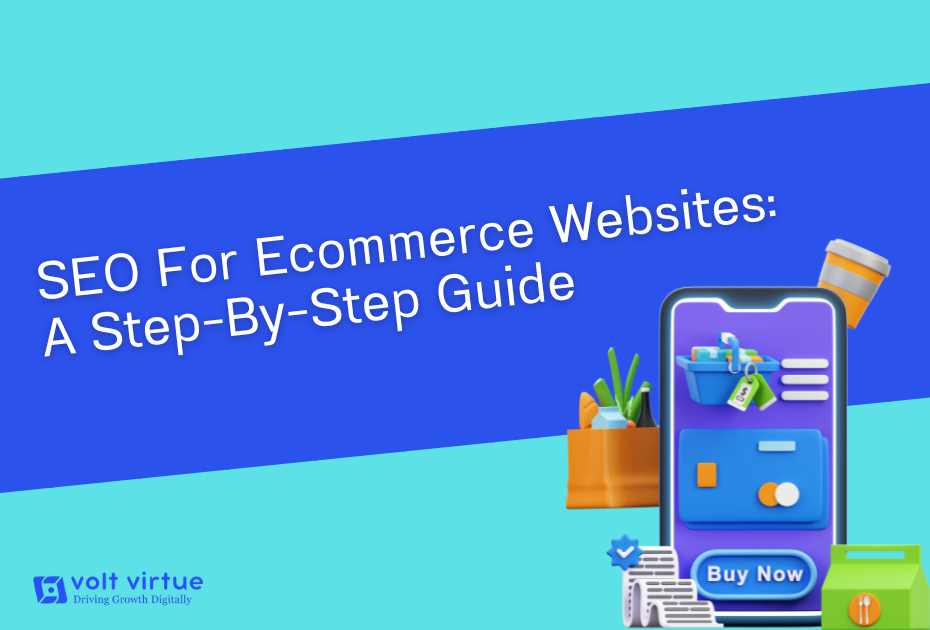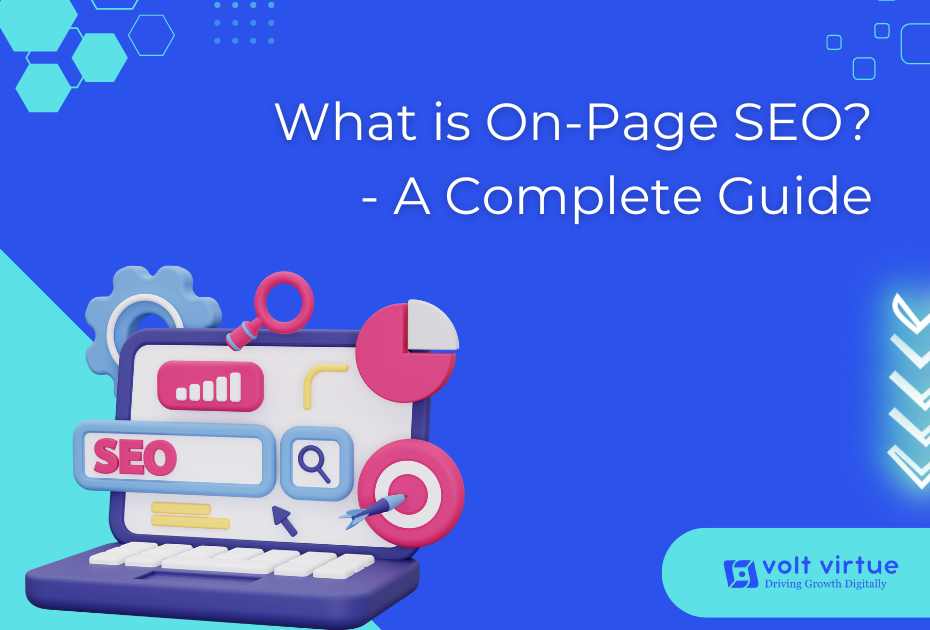
Understanding on-page SEO is crucial for any website aiming to achieve high search engine rankings. On-page SEO focuses on optimizing individual web pages to improve their visibility in search results and attract relevant traffic. This process plays a vital role in ensuring that search engines comprehend your content and deem it relevant to users’ search queries. Let’s explore what on-page SEO is, its key elements, and its role in content optimization.
What is On-Page SEO?
On-page SEO is the process of optimizing web page content to improve visibility for both search engines and users. Common on-page SEO practices involve optimizing title tags, content, internal links, and URLs to improve search engine visibility and user experience. This process helps businesses achieve digital success by enhancing website visibility and delivering a better user experience for their target audience.
Why is On-Page SEO Important?
On-page SEO plays a crucial role in improving a website’s performance and search visibility. Here’s why it matters:
- Enhanced Search Engine Visibility – Optimizing on-page elements ensures that search engines can easily understand and index your content, improving rankings on search engine results pages (SERPs). Higher rankings increase the chances of attracting organic traffic.
- Alignment with User Intent – By refining content, meta tags, and other on-page elements, websites can better match users’ search intent. This helps attract qualified visitors who are genuinely interested in the content, services, or products being offered.
- Improved User Experience – On-page SEO enhances factors like page speed, mobile-friendliness, and content structure, creating a seamless experience for visitors. Fast-loading, well-structured, and easy-to-navigate pages keep users engaged, reduce bounce rates, and improve overall site interactions.
- Competitive Edge – In highly competitive industries, strong on-page SEO can set a website apart. By optimizing content and technical elements, businesses can outperform competitors in search rankings, attract more organic traffic, and establish a stronger digital presence.
- Cost-Effective Strategy – Compared to paid advertising, on-page SEO provides a more budget-friendly way to drive organic traffic. While it requires time and effort to implement, the long-term benefits of strong search rankings often outweigh the costs of continuous ad spending.
- Long-Term Sustainability – Unlike paid marketing strategies that require ongoing investment, well-optimized pages can maintain strong search rankings for months or even years. With regular updates and maintenance, they continue to attract organic traffic over time.
- Adaptability to Algorithm Changes – While search engine algorithms frequently evolve, the core principles of on-page SEO remain consistent. By focusing on high-quality content and technical optimization, websites can adapt to changes and sustain their rankings in search results.
What is the Difference Between On-Page SEO and Off-Page SEO?
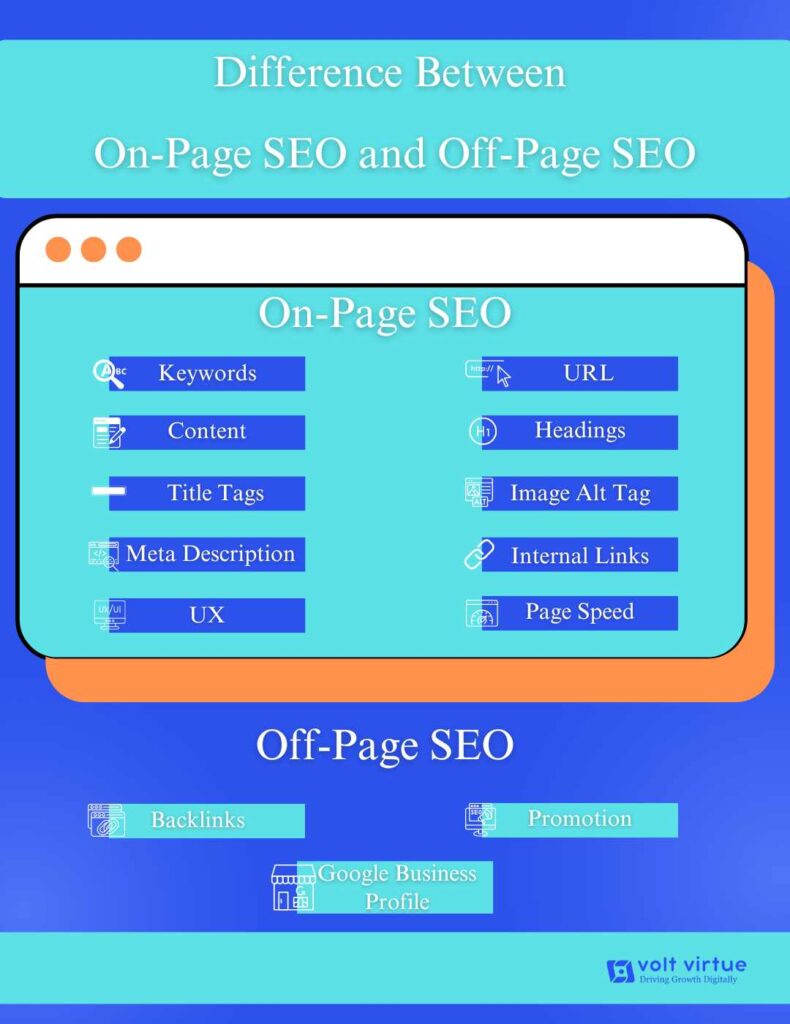
Both On-Page and Off-Page SEO play a crucial role in improving search rankings and driving organic traffic. A balanced approach using both techniques enhances a website’s visibility and authority.
On-Page SEO focuses on optimizing the elements within your website to enhance its visibility and performance in search engine results. This includes high-quality content, relevant keywords, internal linking, meta descriptions, and proper use of tags. Ensuring fresh, unique, and well-structured content helps improve rankings and enhances user experience.
Off-Page SEO strengthens a website’s authority through external factors. It involves backlinks, digital marketing efforts, and social media promotion. A strong Off-Page strategy boosts rankings, but it works best when the site is already optimized with solid On-Page SEO practices.
Both strategies complement each other—while On-Page SEO ensures search engines understand and rank your content, Off-Page SEO builds trust and credibility, helping your site appear higher in search results.
Key Elements of On-Page SEO
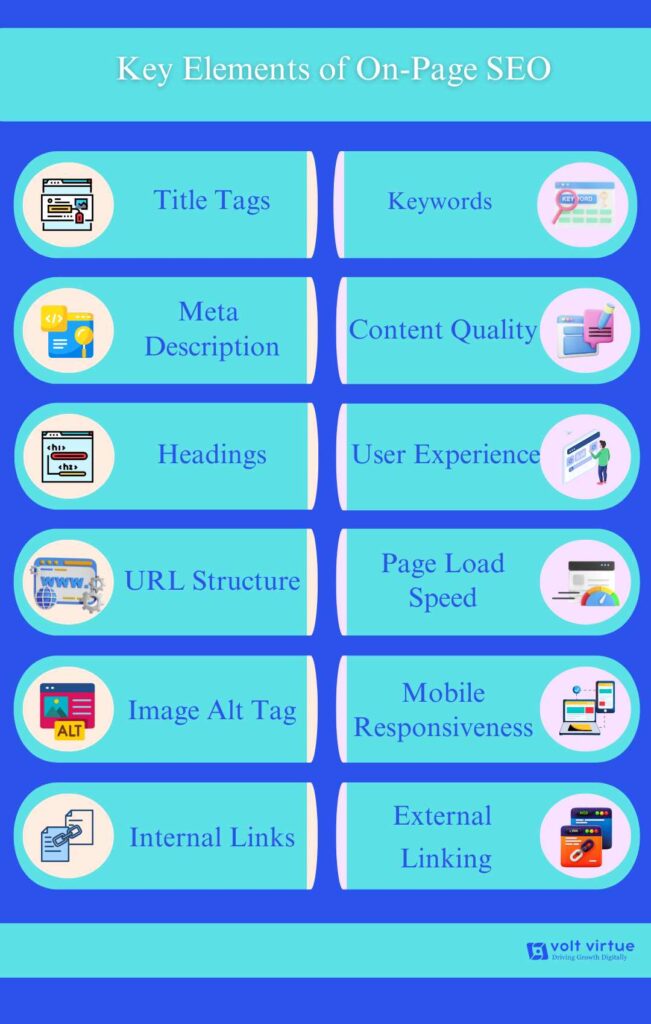
Title Tags
Title tags are crucial for on-page SEO as they serve as the clickable headlines in search engine results. They should accurately represent the page content while incorporating primary keywords. To optimize title tags, keep them under 60 characters to prevent truncation and make them compelling to boost click-through rates and search rankings.
Meta Descriptions
Meta descriptions provide a brief summary of your page’s content and play a vital role in on-page SEO. While they don’t directly impact rankings, they significantly influence click-through rates (CTR) and user engagement.
The meta description should also incorporate the keyword phrase and be concise, staying within 160 characters to effectively summarize the page and encourage clicks.
To optimize meta descriptions:
- Include Primary Keywords – Enhancing relevance helps search engines better match your page to user queries, increasing the chances of attracting clicks.
- Use Attention-Grabbing Modifiers – Words like “Top,” “Complete,” or “Guide” make descriptions more compelling and expand search visibility.
- Keep It Concise & Engaging – A well-crafted meta description should entice users by clearly highlighting how your content addresses their needs, encouraging them to click through.
An important thing to remember about meta descriptions is that Google may sometimes replace your custom description with content from your page to better match a searcher’s query. However, it’s still essential to write a compelling meta description, as it will be displayed when Google doesn’t override it. A well-crafted description improves click-through rates and enhances your page’s visibility.
Headings
Headings (H1, H2, H3, etc.) structure your content, making it easier for both users and search engines to navigate and understand. They provide hierarchy, improve readability, and highlight key topics.
- Use an H1 for the Main Topic – Each page should have a single H1 that clearly represents its primary subject.
- Break Content into Sections with H2s & H3s – Subheadings organize information, making it easier to skim and digest.
- Incorporate Keywords Naturally – Including relevant keywords in headings reinforces content relevance and improves search visibility.
Well-structured headings enhance user experience, keeping visitors engaged while signaling topic importance to search engines. When aligned with title tags and meta descriptions, they contribute to a strong, cohesive on-page SEO strategy.
URL Structure
A clean and concise URL enhances both user experience and search rankings. Incorporate relevant keywords to clearly indicate the page’s topic to search engines and users.
Best Practices for URL Optimization:
- Keep URLs short, readable, and descriptive
- Include primary keywords naturally
- Avoid long, complex, or dynamic URLs with unnecessary characters
A well-structured URL improves clarity, increases click-through rates, and helps search engines better understand your content.
Image Optimization for SEO
Images enhance content by providing context, but they must be optimized for SEO. Key factors include:
Alt Text – Add descriptive alt text to help search engines understand the image and improve accessibility for visually impaired users. Including relevant keywords can also boost SEO.
File Names – Use clear, descriptive file names instead of generic ones like IMG1234.jpg. For example, on-page-seo-graph.jpg is more informative and improves image search rankings.
Compression – Large image files slow down page speed, negatively impacting SEO. Use tools like TinyPNG or ImageOptim to compress images without sacrificing quality, ensuring faster load times and a better user experience.
Internal Links
Internal linking is crucial for improving both user experience and SEO by helping visitors navigate your site and allowing search engines to crawl your content more effectively.
Enhances User Navigation – Internal links create a natural flow, encouraging visitors to explore more pages. When users find relevant links within content, they are more likely to stay engaged and interact with additional resources on your site.
Distributes Link Authority (“Link Juice”) – If a high-ranking page on your site links to a lower-performing one, it passes some of its authority, helping the linked page gain visibility in search results. This improves overall site SEO and boosts rankings for multiple pages.
A well-structured internal linking strategy keeps users engaged, strengthens SEO, and enhances site performance.
Content Quality
High-quality, informative content is essential for improving on-site SEO. It provides value to your audience while aligning with Google’s ranking algorithms, including updates like the “Helpful Content Update” introduced in 2021.
Content that directly answers user questions establishes your website as a trusted source. When visitors stay longer on your site, it reduces bounce rates—signaling to search engines that your content is relevant and engaging. Google’s recent updates prioritize websites that deliver valuable, user-focused information.
Additionally, well-crafted content naturally attracts backlinks, which are crucial for building authority. When reputable sites link to your content, search engines recognize your site as reliable, boosting your rankings.
Google’s algorithms now evaluate content quality more effectively, considering factors like readability, depth, and user engagement. Prioritizing these elements enhances your chances of ranking higher in search results.
Publishing high-quality content consistently also drives organic traffic and encourages social sharing, expanding your reach and strengthening your authority.
User Experience (UX)
User experience (UX) plays a crucial role in on-page SEO, as search engines favor websites that offer a smooth and engaging experience.
Clear and intuitive navigation ensures that visitors can easily find the information they need. Organize content with well-structured menus and internal links to enhance usability. Additionally, fast page load times are essential—slow-loading pages can increase bounce rates and negatively impact rankings.
A mobile-friendly design ensures accessibility across all devices. Responsive layouts, readable fonts, and properly spaced buttons improve usability on smaller screens. Engaging, high-quality content encourages visitors to stay longer and explore further.
A well-optimized UX not only enhances user satisfaction but also signals to search engines that your site delivers value, improving its overall visibility.
Keyword Placement
Keyword placement is a crucial aspect of on-page SEO, helping search engines understand your content and improving its visibility.
Incorporate your primary keyword strategically in key areas, such as the title, headings, and the first 100 words of your content, to emphasize its relevance. Use keywords naturally to maintain readability and avoid keyword stuffing, which can harm both user experience and rankings. Additionally, integrating variations of your target keyword throughout the content ensures broader search intent coverage, attracting a wider audience.
Internal linking is another effective way to optimize keyword placement. Using descriptive anchor text with relevant keywords enhances site navigation for both users and search engines, improving overall SEO performance.
Page Load Speed
Page load speed is a crucial factor in on-page SEO, directly impacting user experience and search engine rankings. Optimizing key elements ensures your website performs efficiently.
Start with a reliable hosting provider. A quality host with servers near your audience reduces latency, while a Content Delivery Network (CDN) distributes content across multiple servers, improving load times for users worldwide.
Minimizing redirects also enhances speed. Each redirect triggers additional server requests, increasing load time. Reducing unnecessary redirects streamlines page performance.
Browser caching further optimizes speed by storing static assets like images and scripts on a user’s device. This eliminates the need to reload them on repeat visits. Setting longer cache durations for static content maximizes efficiency.
Optimizing CSS and JavaScript loading speeds up content rendering. Using “async” or “defer” attributes in script tags prioritizes essential elements, reducing render-blocking and ensuring users see content faster.
Lastly, minify HTML, CSS, and JavaScript by removing unnecessary spaces, comments, and formatting. This reduces file sizes, speeds up browser processing, and enhances overall performance.
By implementing these strategies, you can significantly improve your website’s loading speed, leading to better user engagement and higher search rankings.
Content Freshness
Keeping your content fresh is crucial for maintaining relevance in search results. Search engines prioritize updated pages, especially for topics that evolve frequently.
Regularly reviewing and updating your content ensures accuracy and value. Refresh outdated information, incorporate new insights, and optimize for current search trends. This signals to both users and search engines that your site is active and trustworthy.
Fresh content also presents opportunities to target trending keywords. Updating blog posts with recent data, industry developments, or emerging trends can improve rankings and visibility.
By consistently maintaining up-to-date content, you enhance its relevance, improve engagement, and sustain strong search rankings over time.
Mobile Responsiveness
With mobile-first indexing, Google primarily uses the mobile version of your site for indexing and ranking. This makes mobile responsiveness a critical factor for SEO.
Ensuring your website is fully optimized for mobile improves user experience and search performance. Responsive design, fast-loading pages, and mobile-friendly navigation help maintain engagement and reduce bounce rates.
By prioritizing mobile responsiveness, you set the foundation for a well-optimized B2B site, enhancing both SEO and user experience.
External Linking
External links, or outbound links, connect your website to authoritative sources, adding credibility and context to your content. They play a crucial role in on-page SEO by enhancing trust and demonstrating thorough research.
Linking to reputable, relevant sources signals to both users and search engines that your content is well-supported and reliable. This improves your site’s authority and provides additional value to your audience.
External links also help search engines understand your content’s place within the broader web. However, it’s essential to link only to high-quality, relevant sites. Excessive or irrelevant external links can dilute your SEO efforts.
Use external links strategically to strengthen user experience, improve credibility, and build trust with your audience.
Advanced On-Page SEO Techniques
E-E-A-T: Experience, Expertise, Authoritativeness, and Trustworthiness
E-E-A-T is a critical framework Google uses to assess content quality and website credibility. Strong E-E-A-T signals improve your chances of ranking higher in search results by demonstrating reliability and authority.
- Experience: Show firsthand knowledge or practical expertise by incorporating personal insights, case studies, or real-world examples. This highlights your depth of understanding.
- Expertise: Establish credibility by showcasing qualifications, linking to professional content, or collaborating with subject matter experts. Industry credentials strengthen your authority.
- Authoritativeness: Build recognition as a trusted source by earning backlinks from reputable websites, accumulating positive reviews, and publishing well-researched content.
- Trustworthiness: Ensure reliability with secure website protocols (HTTPS), clear policies, and fact-checked, accurate information that instills confidence in users and search engines.
To optimize for E-E-A-T, produce high-quality, well-researched content, cite reputable sources, and make your expertise easily verifiable. Prioritizing these elements enhances your credibility and improves search rankings.
Core Web Vitals
Core Web Vitals are a set of key performance metrics introduced by Google to assess user experience on a webpage. They focus on three essential aspects:
Improving Core Web Vitals not only boosts search rankings but also enhances user experience, leading to lower bounce rates and higher engagement.
- Largest Contentful Paint (LCP): Measures how quickly the largest visible element—such as an image or heading—loads. A good LCP score is 2.5 seconds or less. Optimize it by using fast hosting, compressing images, and minimizing render-blocking resources like JavaScript and CSS.
- First Input Delay (FID): Evaluates how responsive a webpage is by tracking the time it takes to react to the first user interaction (e.g., clicking a link or button). An ideal score is 100 milliseconds or less. Improve FID by reducing JavaScript execution time, leveraging browser caching, and deferring non-essential scripts.
- Cumulative Layout Shift (CLS): Assesses visual stability by measuring how often elements shift unexpectedly during loading. An acceptable CLS score is 0.1 or less. Enhance stability by setting explicit width and height attributes for images/videos, avoiding content shifts above the fold, and optimizing font-display strategies.
Core Web Vitals are now a crucial part of Google’s ranking factors under the Page Experience Update. Websites that perform well in these areas not only rank higher but also deliver a seamless, frustration-free experience for users.
Schema Markup
Schema markup, or structured data, helps search engines better understand your content by providing contextual information. It acts as a translator between your website and search engines, improving how your pages appear in search results.
Enhances Search Appearance – Using schema markup increases the likelihood of your webpage appearing in rich snippets on search engine results pages (SERPs).
Adds Valuable Information – Rich snippets display extra details beyond the standard title, URL, and description. Depending on the type of content, this may include:
- Review star ratings
- Product prices
- Event dates
- Recipe cook times
By implementing schema markup, you improve search visibility, attract more clicks, and provide users with relevant information at a glance.
On-Page SEO Checklist
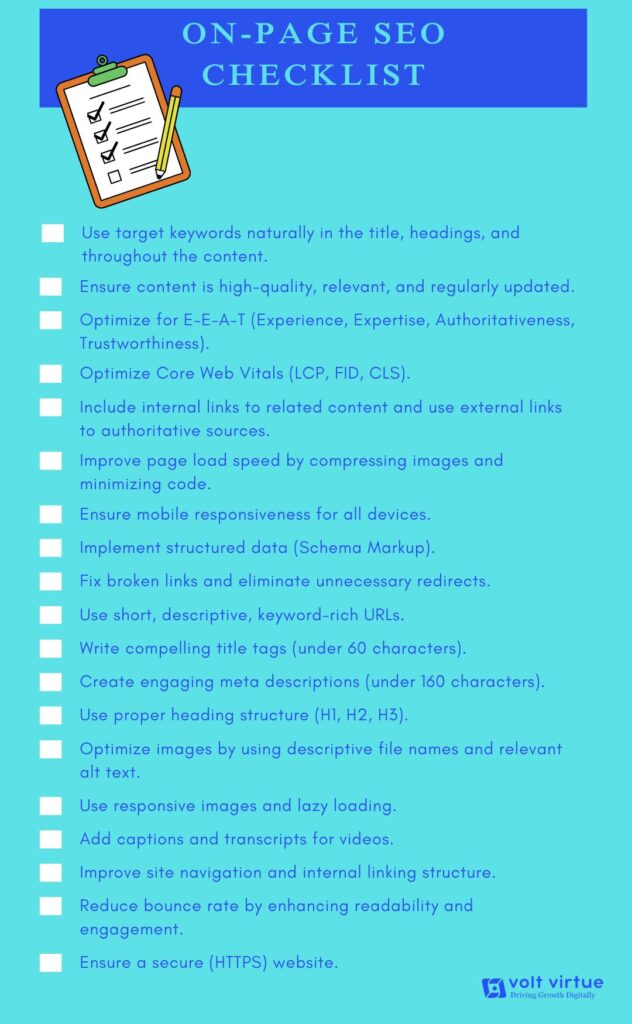
This checklist ensures every aspect of on-page SEO is covered for better rankings and user experience!
Best On-Page SEO Software to Use
Several on-page SEO tools can help optimize your website effectively. Here are some of the best choices:
SEMrush – A comprehensive SEO tool offering keyword research, site audits, competitor analysis, and on-page SEO optimization with actionable insights to improve rankings.
Ahrefs – Features site auditing, keyword research, backlink analysis, and content optimization recommendations. The Site Audit tool helps identify on-page issues and suggests improvements.
Moz Pro – Provides on-page SEO tools such as keyword research, site auditing, and rank tracking. The Page Optimization feature offers recommendations for title tags, meta descriptions, and headings.
Google Search Console – A free tool from Google that provides insights into search performance, indexing issues, and on-page optimization opportunities.
Yoast SEO – A WordPress plugin that optimizes on-page elements like content readability, meta tags, and XML sitemaps, offering real-time feedback.
Screaming Frog SEO Spider – A desktop-based tool that crawls websites to detect broken links, duplicate content, and missing meta tags, providing in-depth reports for optimization.
PageSpeed Insights – A free Google tool that analyzes page performance and provides recommendations to improve loading speed and user experience, essential for on-page SEO.
These tools cater to different SEO needs, so selecting one that aligns with your goals and budget will help enhance your on-page SEO performance effectively.
How to Manage On-Page SEO at Scale
Managing on-page SEO across a large website with extensive content requires a structured approach. Here’s how to efficiently optimize and maintain SEO at scale:
Conduct Regular SEO Audits
Use tools like Screaming Frog, SEMrush, or Ahrefs to identify broken links, missing meta tags, improper header usage, and other technical issues. Regular audits help maintain SEO consistency across all pages.
Conduct Keyword Research
Identify and target relevant keywords that match user search intent..
Optimize Content in Bulk
Identify underperforming pages and update them in batches by refreshing outdated information, refining keyword usage, and improving readability to enhance engagement and search visibility.
Optimize URLs, Page Titles, and Meta Descriptions
Review and Update URLs – Ensure URLs are concise, descriptive, and include relevant keywords without unnecessary characters or stop words.
Optimize Page Titles – Keep titles clear, engaging, and within the recommended length (50-60 characters) to avoid truncation in search results.
Refine Meta Descriptions – Craft compelling descriptions within 155-160 characters to provide a clear summary of the page. Avoid keyword stuffing while ensuring relevance and readability.
Avoid Repetition – Prevent redundancy in keywords and ensure each title and description is unique to enhance SEO and user experience.
Leverage Internal Linking
Implement a structured internal linking strategy to help search engines crawl and index your pages efficiently while improving user navigation and content discoverability.
Monitor Performance Metrics
Regularly track key SEO indicators such as rankings, organic traffic, and user engagement using tools like Google Search Console and Google Analytics. Adjust strategies based on data insights for continuous improvement.
Automate SEO Tasks
Use automation tools to streamline tasks like generating XML sitemaps, identifying duplicate content, and fixing broken links. This saves time and ensures website health and efficiency.
Common Mistakes to Avoid in On-Page SEO
Even with a strong grasp of on-page SEO, certain mistakes can negatively impact your website’s performance. Here are key pitfalls to avoid and why they matter:
- Keyword Stuffing and Over-Optimization: While keywords are essential for SEO, excessive use—especially in titles, content, or meta tags—can harm rankings. Search engines prioritize readability and penalize keyword stuffing, as it disrupts user experience. Instead, focus on naturally incorporating keywords into valuable, well-structured content.
- Ignoring Mobile Responsiveness: With over 63% of global web traffic coming from mobile devices, a non-mobile-friendly site risks losing a significant audience. Additionally, Google ranks mobile-friendly websites higher in search results. Implement responsive design to ensure your site adapts seamlessly to all screen sizes.
- Neglecting Content Updates: Outdated content can reduce your site’s relevance and credibility. Search engines favor fresh, high-quality content that aligns with current search intent. Regularly audit older articles, updating them with new data, recent examples, and relevant keywords to maintain their effectiveness.
- Neglecting Internal Linking: Internal links help users navigate your website and distribute link equity effectively. Failing to link to relevant pages can reduce engagement, hurt SEO, and miss opportunities to showcase valuable content. Ensure each page includes meaningful internal links to enhance user experience and authority.
- Overlooking Page Speed Optimization: Slow-loading pages increase bounce rates and frustrate users. Tools like Google PageSpeed Insights can help identify issues such as uncompressed images or excessive JavaScript. Optimizing these elements improves both site performance and search rankings.
- Using Duplicate or Thin Content: Publishing low-quality, short, or duplicated content can lead to penalties from search engines. Instead, focus on creating original, valuable, and in-depth content that directly addresses user queries.
- Ignoring Search Intent: Content that doesn’t align with what users are searching for can lead to poor engagement. Determine whether your audience is looking for information, products, or actionable solutions, and tailor your content accordingly to meet their needs.
Measuring and Monitoring On-Page SEO
To evaluate the effectiveness of your on-page SEO, track key performance indicators (KPIs) that reflect both search engine performance and user engagement. Here are the essential metrics to monitor:
- Organic Traffic: Measure the number of visitors arriving from search engines. Growth in organic traffic indicates that your SEO efforts—such as keyword optimization and enhanced meta tags—are driving results.
- Bounce Rate: This metric tracks the percentage of visitors who leave after viewing only one page. A high bounce rate may suggest that content isn’t engaging or that the page fails to meet user expectations. Improve navigation, enhance content quality, and optimize page speed to reduce bounce rates.
- Time on Page: The longer users stay on a page, the more likely it is that they find the content valuable. Enhance engagement by providing in-depth, user-focused content, supported by visuals, videos, or interactive elements.
- Keyword Rankings: Track where your pages rank for target keywords in search results. Regularly monitoring rankings helps assess whether your on-page SEO adjustments are effective. Tools like SEMrush or Ahrefs can highlight ranking trends and areas for improvement.
- Click-Through Rate (CTR): This measures the percentage of users who click on your page from search engine results. A low CTR could mean your title tags and meta descriptions aren’t compelling enough. Experiment with engaging, keyword-rich copy to boost clicks.
- Core Web Vitals: These performance metrics—Largest Contentful Paint (LCP), First Input Delay (FID), and Cumulative Layout Shift (CLS)—assess page loading speed, interactivity, and visual stability. Optimizing these factors improves user experience and supports better search rankings.
Conclusion
On-page SEO plays a crucial role in a successful digital marketing strategy. By creating high-quality content, optimizing meta tags and URLs, enhancing user experience, and continuously monitoring performance, businesses can improve search rankings and attract more organic traffic.
While the fundamentals of on-page SEO remain constant, staying updated with evolving trends and best practices is essential. A commitment to ongoing optimization and data-driven insights ensures long-term success, helping businesses maintain a competitive edge in an ever-changing digital landscape.
Frequently Asked Questions (FAQs) on On-Page SEO
1. How is on-page SEO different from technical SEO?
Answer: On-page SEO focuses on optimizing visible elements such as content, images, headings, and meta tags to enhance user experience and relevance. In contrast, technical SEO deals with backend factors like site speed, SSL security, and XML sitemaps, ensuring search engines can efficiently crawl and index a website. For example, a B2B tech company might optimize product pages with targeted keywords (on-page SEO) while ensuring fast loading speeds and mobile-friendliness (technical SEO) to improve search rankings.
2. Can on-page SEO improve local search rankings?
Answer: Yes, optimizing on-page elements like NAP (Name, Address, Phone Number) details, local keywords, and region-specific content can significantly boost local search visibility. For instance, a B2B distributor can enhance local rankings by including city or region names in page titles, meta descriptions, and website copy, making their business more relevant to local search queries.
3. What are some common on-page SEO misconceptions that may result in penalties?
Answer: One major misconception is that excessive keyword usage improves rankings. This practice, known as keyword stuffing, can hurt readability and user experience, potentially leading to search engine penalties. Instead, B2B companies should prioritize high-quality, informative content that naturally integrates well-researched keywords to maintain both relevance and readability.
4. What is On-Page Content Optimization?
Answer: On-page content optimization involves strategically incorporating relevant keywords while prioritizing clear, informative, and user-focused content. It also includes crafting compelling headlines and meta descriptions to boost click-through rates and structuring content with headers and subheadings for easy readability.
5. How Can I Measure the Success of My On-Page SEO Efforts?
Answer: You can track on-page SEO performance using tools like Google Analytics and Google Search Console. Key metrics to monitor include organic traffic, keyword rankings, click-through rates (CTR), and user engagement to evaluate effectiveness and identify areas for improvement.
6. Are There Tools to Assist with On-Page SEO?
Answer: Yes, various tools can help optimize on-page SEO. Platforms like Semrush, Moz, and Ahrefs provide features for keyword research, content analysis, and performance tracking. Using these tools can streamline the optimization process and offer valuable insights for improving search visibility.

